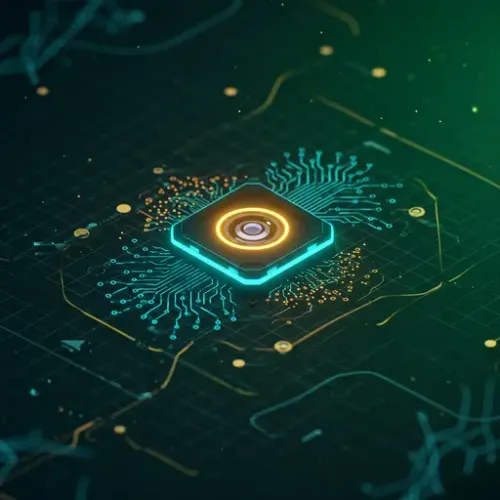Mastering Advanced Object Recognition: Integrating Deepstack AI with Home Assistant for Custom Automations

NGC 224
DIY Smart Home Creator
Introduction: Elevating Smart Home Security Beyond Basic Motion
Generic motion detection is often the bane of smart home security, flooding your notifications with false positives triggered by swaying trees, passing cars, or pets. The real power of a vigilant smart home comes from understanding what caused the motion. Enter Deepstack AI – a local, privacy-focused computer vision engine that can perform advanced object recognition, facial recognition, and scene analysis. Integrating Deepstack with Home Assistant allows you to move beyond simple 'motion detected' alerts to truly intelligent automations based on specific objects, like a 'person' at your door, a 'package' left on your porch, or even identifying specific individuals.
This guide will equip you with the practical steps and configurations needed to deploy Deepstack, seamlessly integrate it with your Home Assistant instance, and craft powerful, event-driven automations that respond to precise object detections. We'll cover everything from Docker deployment to YAML configurations and advanced optimization, empowering you to build a more intelligent and less noisy smart home security system.
Step-by-Step Setup: Deepstack & Home Assistant Integration
1. Deploying Deepstack with Docker
Deepstack is best run in a Docker container, offering isolation and easy management. You can choose between a CPU-only version (deepstackai/deepstack:latest) or a GPU-accelerated version (deepstackai/deepstack:gpu) if your system has an NVIDIA GPU. For most setups, the CPU version is sufficient to start.
First, ensure Docker is installed on your Home Assistant host or a separate server on your network. Then, execute the following command:
docker run -d --restart always \
--name deepstack \
-p 5000:5000 \
-e VISION-DETECTION=True \
-e API-KEY="YOUR_STRONG_API_KEY" \
deepstackai/deepstack:latest
Explanation:
-d --restart always: Runs the container in the background and restarts it automatically.--name deepstack: Assigns a memorable name to your container.-p 5000:5000: Maps port 5000 on your host to port 5000 in the container (Deepstack's default port).-e VISION-DETECTION=True: Enables the object detection module. For facial recognition, you'd useVISION-FACE=True.-e API-KEY="YOUR_STRONG_API_KEY": Crucially, replaceYOUR_STRONG_API_KEYwith a robust, unique API key. This secures your Deepstack instance from unauthorized access.deepstackai/deepstack:latest: Specifies the Docker image. Usedeepstackai/deepstack:gpufor GPU acceleration (requires NVIDIA Docker runtime).
Verify Deepstack is running by navigating to http://YOUR_DEEPSTACK_IP:5000/v1/vision/detection in your browser. You should see a blank page or a 'Method Not Allowed' error, indicating the service is active.
[Screenshot Placeholder: Docker container list showing Deepstack running]
2. Integrating Deepstack into Home Assistant
Home Assistant integrates with Deepstack via its image_processing platform. You'll add this configuration to your configuration.yaml file or a dedicated package file.
# configuration.yaml
image_processing:
- platform: deepstack
ip_address: YOUR_DEEPSTACK_IP
port: 5000
api_key: "YOUR_STRONG_API_KEY" # Must match the key used in Docker
save_file_folder: /config/www/deepstack_detections # Optional: folder to save detected images
save_file_format: png
source:
- entity_id: camera.front_door
name: deepstack_front_door_object
- entity_id: camera.back_yard
name: deepstack_back_yard_object
targets:
- person
- package
- cat
- dog
Configuration Breakdown:
ip_address: Replace with the IP address of your Deepstack Docker host.port: Default is5000.api_key: Crucially, this must exactly match theAPI-KEYset in your Docker run command.save_file_folder: (Optional) If specified, Deepstack will save a snapshot of the image with bounding boxes drawn around detected objects. This folder must be accessible by Home Assistant (e.g.,/config/www/for web access).source: A list of camera entities (camera.front_door,camera.back_yard) that Deepstack will process. Each camera gets a uniqueimage_processingentity (e.g.,image_processing.deepstack_front_door_object).targets: (Optional) A list of specific objects you want Deepstack to look for. This helps filter out irrelevant detections and can slightly improve performance. Deepstack supports a wide range of common objects (e.g.,car,truck,bicycle,tv,bird).
After adding this, restart Home Assistant. You should now see new image_processing entities in your Developer Tools.
[Screenshot Placeholder: Home Assistant Developer Tools showing new `image_processing` entity]
3. Creating Automation Triggers with Deepstack Detections
The image_processing entity exposes several attributes crucial for automations:
state: The number of detected objects.summary: A dictionary of detected objects and their counts (e.g.,{'person': 1, 'cat': 0}).total_persons,total_packages, etc.: Specific counts for each target if defined.detections: A list of detailed detection objects, including bounding box coordinates and confidence.
Let's create an automation that triggers when a 'person' is detected by the front door camera and sends a notification with the captured image.
# automations.yaml
- alias: "Front Door Person Detection Alert"
id: front_door_person_detection_alert
trigger:
- platform: state
entity_id: image_processing.deepstack_front_door_object
# Trigger when the number of detected objects changes to 1 or more
to: "1"
condition:
# Ensure 'person' is specifically detected (optional, but good practice)
- condition: template
value_template: "{{ state_attr('image_processing.deepstack_front_door_object', 'summary').person > 0 }}"
action:
- service: notify.mobile_app_your_phone
data_template:
title: "Person Detected at Front Door!"
message: "A person was seen at the front door. Confidence: {{ state_attr('image_processing.deepstack_front_door_object', 'detections')[0].confidence | round(2) * 100 }}%"
data:
image: "{{ states('camera.front_door') }}" # Uses the camera stream directly
# or if saving files: "{{ url_path }}deepstack_detections/deepstack_front_door_object_latest.png?{{ now().timestamp() }}"
attachment:
url: "{{ states('camera.front_door') }}"
content_type: "jpeg"
actions:
- action: "VIEW_CAM_FRONT_DOOR"
title: "View Live Stream"
This automation triggers when the image_processing.deepstack_front_door_object state changes to 1 (indicating at least one object detected). The condition specifically checks for a 'person' in the summary attribute. The action sends a rich notification, including the camera snapshot.
Troubleshooting Section
Deepstack Container Issues
- Container Not Running: Check
docker ps -a. If Deepstack isn't listed or shows an exited state, usedocker logs deepstackto diagnose. Common issues are port conflicts (another service using 5000) or missing environment variables. - API Key Mismatch: If Home Assistant reports authentication errors, double-check that the
API-KEYin your Docker command precisely matches theapi_keyin your Home Assistant configuration. - High CPU/Memory Usage: Deepstack is resource-intensive. If your host struggles, consider upgrading hardware or reducing the frequency of image processing.
Home Assistant image_processing Errors
- Entity Not Showing Up: After configuring, ensure you restart Home Assistant, not just reload automations. Check Home Assistant logs (
home-assistant.log) for any errors related to the Deepstack platform. - No Detections: Ensure your cameras are providing valid snapshots. Check the camera's stream directly. If Deepstack is configured to save images, verify files are appearing in your
save_file_folder. If no bounding boxes appear on saved images, Deepstack might not be detecting anything or has a configuration issue. - Deepstack Not Reachable: Verify network connectivity between your Home Assistant host and the Deepstack Docker host. Ping the Deepstack IP address from your Home Assistant host. Check firewall rules.
False Positives/Negatives
- False Positives: Adjust Deepstack's confidence threshold. The Home Assistant integration allows a
confidenceparameter (e.g.,confidence: 80for 80%). Higher values reduce false positives but might miss some legitimate detections. Also, refine your camera's field of view. - False Negatives: Ensure image quality from your camera is good (sufficient resolution, lighting). Consider sending more frequent snapshots or adjusting your camera's motion detection sensitivity to capture the event better. Deepstack's default models are trained on common objects; very unusual poses or partial views can be missed.
Advanced Configuration / Optimization
Conditional Processing with Templates
To reduce CPU load on Deepstack, only process images when necessary. For instance, only analyze a camera feed if a simpler motion sensor has already been triggered:
# automation to trigger Deepstack processing
- alias: "Process Front Door for Objects on Motion"
trigger:
- platform: state
entity_id: binary_sensor.front_door_motion_sensor
to: "on"
action:
- service: image_processing.scan
data:
entity_id: image_processing.deepstack_front_door_object
This approach means Deepstack isn't constantly analyzing images, only when motion is confirmed, significantly saving resources.
Hardware Acceleration (GPU)
If you have an NVIDIA GPU, Deepstack's performance can be dramatically improved. Ensure you have the NVIDIA Container Toolkit installed, then use the deepstackai/deepstack:gpu image and add --runtime=nvidia to your Docker command:
docker run -d --restart always \
--runtime=nvidia \
--name deepstack-gpu \
-p 5000:5000 \
-e VISION-DETECTION=True \
-e API-KEY="YOUR_STRONG_API_KEY" \
deepstackai/deepstack:gpu
Zone-Based Detection
Deepstack allows you to define specific zones within an image to only detect objects in those areas. This is useful for ignoring public sidewalks or parts of your yard that don't need monitoring. This is handled by a custom component or by pre-processing images to crop them before sending to Deepstack. A simpler approach is to use the zone option in some camera integrations (like Frigate) before passing cropped images to Deepstack.
Real-World Example: Smart Package Delivery & Theft Deterrence
Let's create an advanced automation for package detection and a theft deterrence strategy.
# automations.yaml
# 1. Notify on Package Delivery
- alias: "Package Delivered Notification"
id: package_delivered_notification
trigger:
- platform: state
entity_id: image_processing.deepstack_front_door_object
to: "1"
condition:
- condition: template
value_template: "{{ state_attr('image_processing.deepstack_front_door_object', 'summary').package > 0 }}"
- condition: not # Prevent repeated notifications for the same package
alias: "Only once per package until cleared"
conditions:
- condition: state
entity_id: input_boolean.package_delivered_flag
state: "on"
action:
- service: input_boolean.turn_on
entity_id: input_boolean.package_delivered_flag
- service: notify.mobile_app_your_phone
data_template:
title: "📦 Package Delivered!"
message: "A package has been detected at your front door."
data:
image: "{{ states('camera.front_door') }}"
actions:
- action: "VIEW_CAM_FRONT_DOOR"
title: "View Live"
- action: "DISMISS_PACKAGE_ALERT"
title: "Clear Alert" # Clears the flag, ready for next package
# 2. Package Theft Deterrence (requires another camera or specific detection logic)
- alias: "Deter Package Theft"
id: deter_package_theft
trigger:
- platform: state
entity_id: image_processing.deepstack_front_door_object
# Trigger when a person is detected AND a package is present
to: "1"
condition:
- condition: template
value_template: "{{ state_attr('image_processing.deepstack_front_door_object', 'summary').person > 0 }}"
- condition: template
value_template: "{{ state_attr('image_processing.deepstack_front_door_object', 'summary').package > 0 }}"
- condition: state
entity_id: input_boolean.package_delivered_flag
state: "on" # Only if a package was previously detected as delivered
action:
- service: light.turn_on
target:
entity_id: light.front_porch_light
data:
brightness_pct: 100
flash: short
- service: media_player.play_media
target:
entity_id: media_player.outdoor_speaker
data:
media_content_id: "https://www.example.com/audio/intruder_alert.mp3" # A loud warning sound
media_content_type: "audio/mp3"
- service: notify.mobile_app_your_phone
data:
title: "🚨 Possible Package Theft!"
message: "A person is near a delivered package at the front door."
# Helper input_boolean to track package presence
input_boolean:
package_delivered_flag:
name: Package Delivered Flag
initial: off
icon: mdi:package
# Automation to clear the package flag via notification action (requires mobile app actions config)
- alias: "Clear Package Delivered Flag"
id: clear_package_delivered_flag
trigger:
- platform: event
event_type: mobile_app_notification_action
event_data:
action: "DISMISS_PACKAGE_ALERT"
action:
- service: input_boolean.turn_off
entity_id: input_boolean.package_delivered_flag
This setup uses an input_boolean to prevent repeated delivery notifications and allows a manual reset. The theft deterrence automation specifically checks for both a 'person' and a 'package' and triggers a deterrent action only if a package was previously flagged as delivered, minimizing false alarms.
Best Practices & Wrap-up
Privacy & Security
- Local Processing: Deepstack runs locally, meaning your sensitive camera data never leaves your network for AI processing, unlike many cloud-based solutions. This is a significant privacy advantage.
- API Key: Always use a strong, unique API key for Deepstack to prevent unauthorized access to its API endpoint.
- Network Isolation: If possible, run Deepstack on a separate VLAN or network segment from your main home network to further enhance security.
Performance & Scalability
- Snapshot Frequency: Avoid sending images to Deepstack too frequently. Balance detection responsiveness with CPU load. Conditional processing (only scanning on motion) is key.
- Targeted Detections: Use the
targetsparameter in Home Assistant's Deepstack configuration to limit what Deepstack looks for. This can slightly reduce processing time. - Hardware: For multiple cameras or high-frequency processing, consider dedicated hardware, especially with GPU acceleration.
- Multiple Deepstack Instances: For very demanding scenarios, you can run multiple Deepstack containers, each configured for different cameras or detection types (e.g., one for objects, another for faces), and point different Home Assistant
image_processingentities to them.
Reliability & Maintenance
- Docker Watchtower: Consider using Watchtower to automatically update your Deepstack Docker container to the latest version, ensuring you have the most up-to-date models and bug fixes.
- Home Assistant Updates: Keep Home Assistant updated. Changes in core functionality can sometimes affect custom integrations or platforms.
- Monitoring: Monitor your Deepstack Docker container and Home Assistant logs for errors or unusual resource usage to preemptively address issues.
By mastering Deepstack AI integration, you transform your Home Assistant into a truly intelligent observer, capable of understanding the nuances of your physical environment and responding with precision. This unlocks a new realm of advanced automations, making your smart home not just reactive, but genuinely proactive and smart.

NGC 224
Author bio: DIY Smart Home Creator
